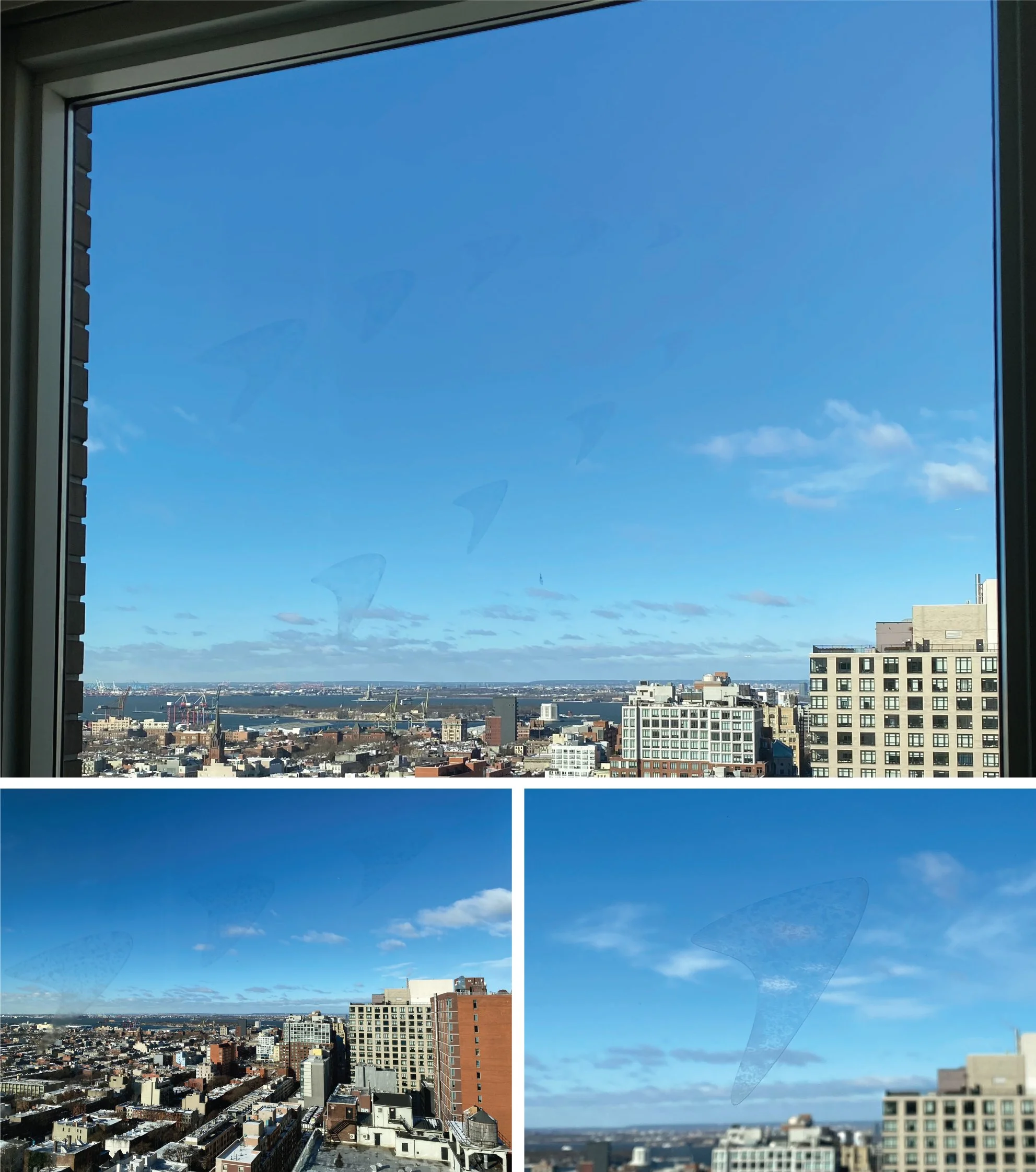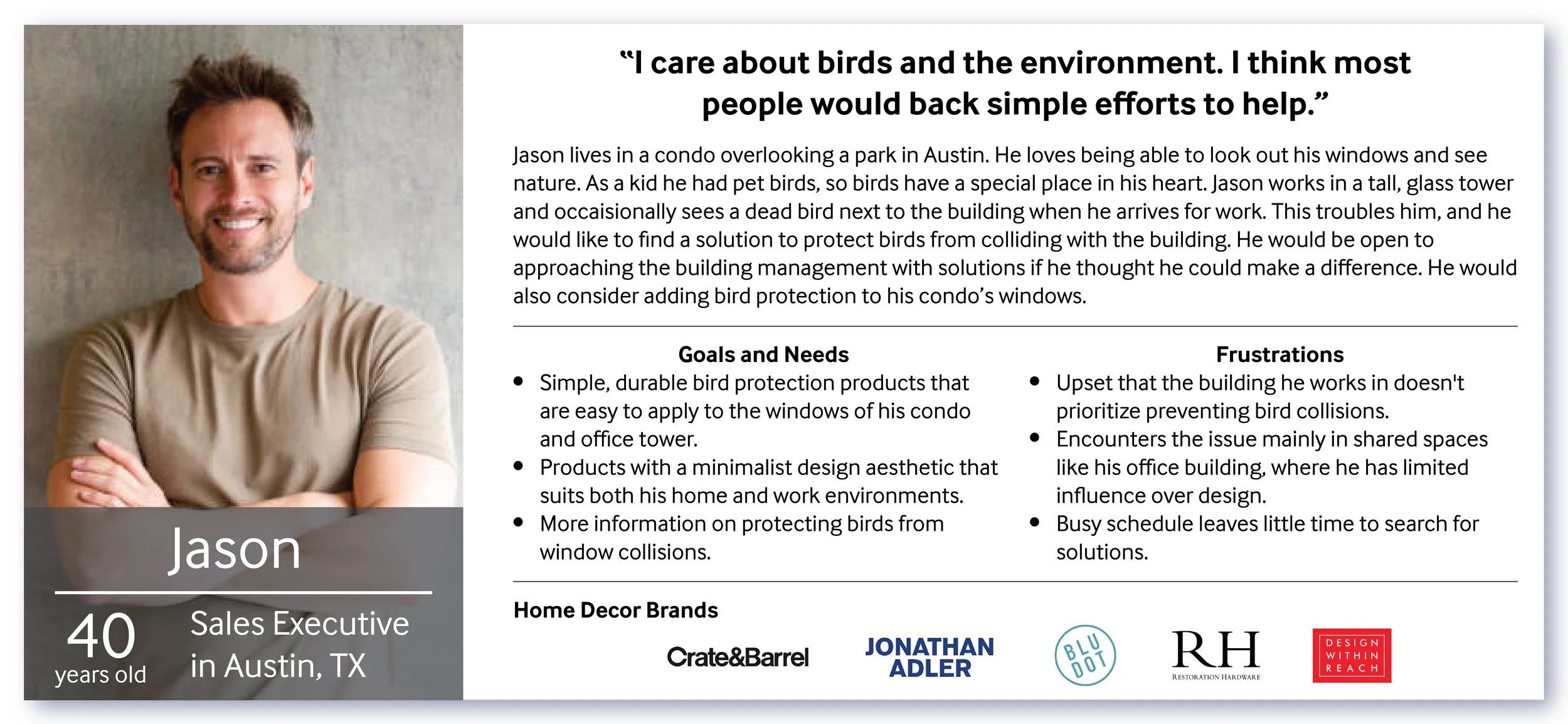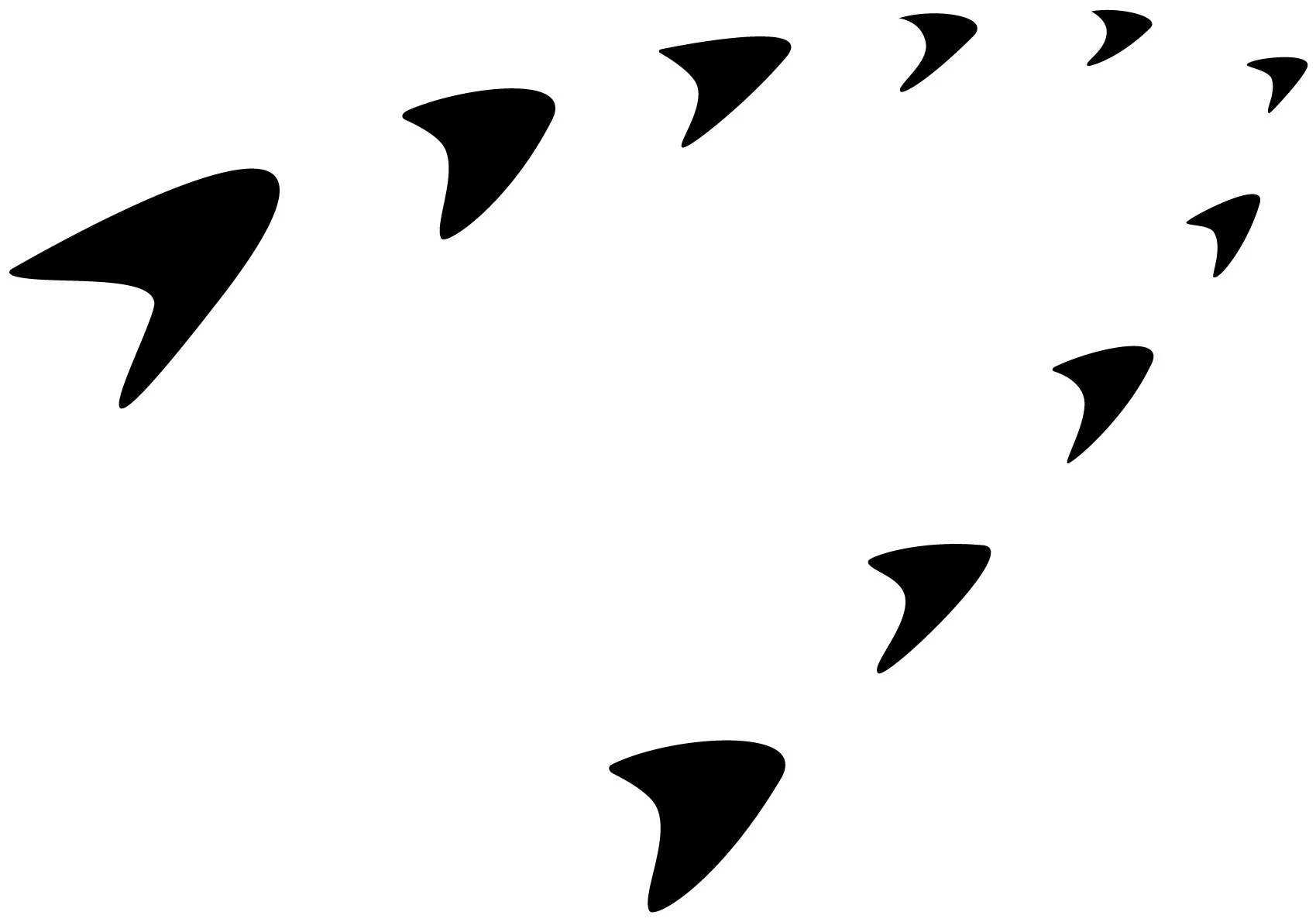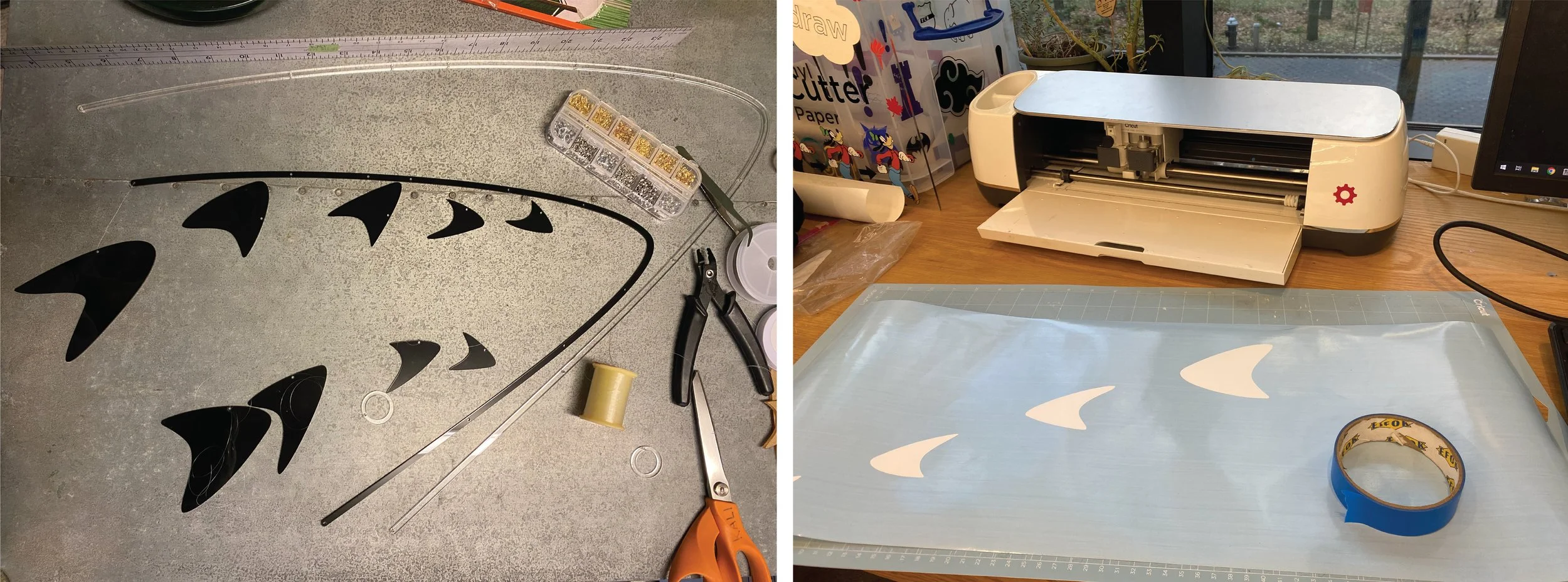
UX Research and Biomimicry Design for Product Ideation
UX Research, Biomimicry Design
Objective: Conduct research into spider webs and use a biomimetic approach to ideate, design and construct a new product
Result: Designed two products that protect birds from window collisions using UV light, and that educate users about the problem.
Team: Kali Birdsall, Simran Chhabra & Phoebe Pang
My Role: Researcher & Designer responsible for topical research, user research, ideation and design.
Duration: 4 weeks
Tools: Research, Laser Cutter, Vinyl Cutter, Cricut
Project Overview
Research-Lead Ideation to Define and Solve a Problem
At the onset of this project, we didn't have a final product in mind and we didn’t know which problem we wanted to solve; instead, we allowed the research to guide us, reveal a problem, and inspire our product. This research-driven approach to ideation enabled us to identify a pressing environmental problem, and then to create a unique solution that we wouldn't have envisioned otherwise. The experience was profoundly enlightening for our team.
We adopted a biomimetic design approach, studying spider webs to develop a solution for our users' pressing needs. By carefully analyzing how spiders engineer their webs, we translated nature's elegant principles into innovative product features.
We focused our research around how some spiders use UV reflective silk to make their webs, in part to make their webs more visible to birds. This drew our attention to how birds use their ability to see the UV light spectrum in their navigation, and inspired our product: window decor that prevents birds from colliding with windows.
We discovered that bird window collisions are an enormous problem with wide-reaching environmental consequences. It is estimated that in the US alone, up to 1 billion birds collide with windows every year, and the majority of collisions are fatal.
Biomimicry
Biomimicry is the practice of seeking sustainable solutions to human problems by emulating nature’s patterns and strategies. Nature offers an abundance of unique strategies that work harmoniously within the environment. The goal is to create products that address design challenges sustainably, fostering coexistence with all life on Earth. By adhering to a biomimetic approach in our research and design, we uncovered a unique solution to an important problem.
Process
Research Methods and Planning
Our research, ideation and prototyping process included multiple research methods:
Mind mapping
Internet & library research
Art & design research
Expert interviews
User surveys & user interviews
Affinity diagrams
Personas
Mood boards
Sketching
Prototyping & iteration
Our Solution: Final Designs
Window Decals
The decals are nearly invisible to the human eye (and difficult to photograph for my portfolio), but the UV reflection makes them highly visible to birds, indicating to birds that there is a barrier to avoid.
Right: what birds see (approx).
Left: what humans see.
DECAL
Window decals, detail views.
Window Mobiles
We developed two versions of our window mobile: a transparent, UV-reflective acrylic mobile, and an opaque black colorway. While both versions effectively serve their protective function, they also offer users different aesthetic choices. The clear version integrates subtly with existing interior decor, while the black variation creates a bolder aesthetic statement. This dual approach ensures our product appeals to diverse interior styles while maintaining its core functionality.
Window mobiles, detail views.
Foundational Research
In Search of Inspiration
In our quest to innovate our product design, we undertook an extensive study of spider webs, seeking inspiration from their unique properties. Our research encompassed a broad spectrum of topics, including various web structures, the meticulous process of web construction, and the exceptional qualities of spider silk. We also examined how spider webs have influenced artists and designers. Throughout this exploration, we uncovered numerous fascinating insights and identified many aspects that could inspire our design process.
Spider Web Structures
We learned about the various structures that different species of spiders make out of silk.
Web Architectures:
Orb webs - the classic spiral wheel design made by garden spiders
Sheet webs - horizontal platforms with irregular threads above
Cobwebs (tangle webs) - the irregular, three-dimensional meshes made by house spiders
Funnel webs - sheet webs with a tunnel retreat
Triangle webs - minimal Y-shaped webs made by ray spiders
Bowl and doily webs - a bowl-shaped web with a smaller horizontal sheet below
Ladder webs - vertical rectangles with regular cross pieces
Non-Web Silk Structures:
Draglines - safety lines spiders trail behind them
Egg sacs - protective cocoons for eggs
Ballooning threads - used for wind dispersal
Retreat structures - hidden shelters lined with silk
Sperm webs - small webs males build to transfer sperm to their palps
Prey wrap - silk used to immobilize captured prey
Attachment discs - strong anchor points for other silk structures
Bridge threads - initial structural lines between points
Spider Silk
We learned that spider silk has numerous unique characteristics, and we learned how a spider actually makes silk.
Spider silk has inspired numerous biomimetic innovations, but despite decades of research, scientists haven't yet managed to mass-produce synthetic spider silk that fully matches natural silk's properties.
The secret to spider silk's incredible properties lies in its molecular structure of crystalline regions (providing strength) interspersed with flexible amorphous regions (providing elasticity), a design that scientists have struggled to fully replicate synthetically.
Some spiders can produce up to seven different types of silk from different glands, each with unique properties - like tough dragline silk for web frames, sticky capture silk for prey, and soft silk for egg protection.
Spider silk is five times stronger than steel by weight and can stretch up to 40% of its length without breaking, making it not only one of the strongest natural fibers but also remarkably elastic.
Spiders produce silk by extruding liquid protein through specialized glands called spinnerets, where he protein solution transforms into solid fibers through a combination of mechanical stretching and chemical changes as it contacts the air.
A Spider and its Web
Spiders have evolved to efficiently use their webs for a variety of tasks.
Prey Capture - Intercepts and immobilizes flying insects using sticky spiral threads
Predator Warning / Sensory Tool - Acts as a vibration detection system to alert spiders of prey or threats
Territory Marking - Establishes the spider's hunting zone and optimal position
Movement Platform - Provides efficient travel routes while maintaining safety lines
Mating Arena - Facilitates courtship through specific vibration patterns
Environmental Protection - Creates shelters from weather and predators
Communication Network - Transmits environmental information through web vibrations
Energy Recycling - Spiders frequently eat then rebuild their webs. By eating the silk, they recapture the protein and energy used to make the web.
Art Inspiration
Many artists have been inspired by spiders and spider webs. Artists have thought about webs as an extension of the spiders’ bodily cognition, as ecosystems and webs of interaction, as distinct geometrical architecture, and as references to the transient nature of beauty and life.
Artworks above are by (clockwise) Mona Hatoum, Tomás Saraceno, Louise Bourgeois, and Chiharu Shiota
Ultraviolet Light
We were most inspired to learn that some spiders use UV-reflecting silk to make their webs. This prevents birds (who can see UV light, unlike humans) from flying into their webs and destroying them. The UV-reflection also attracts insect prey to a web.
Additionally, we came across several companies that make windows with UV-reflecting properties that help prevent birds from flying into them.
Inspiration Strikes!
Early Ideation
We started to piece together certain aspects of our research into product ideas.
The way spiders use UV light reflection in their webs to prevent birds from flying into the webs intrigued us.
We started thinking about products we could make that would use UV reflection to prevent birds from colliding with windows like clear UV vinyl decals, or UV-reflective window hangings.
With these ideas in mind, we needed to conduct a little more research to fill in our knowledge.
Additional Research
Ultraviolet Light: Human Vision vs. Bird Vision
We needed to understand more about how birds and humans see the UV light spectrum as part of our ideation process. We learned that humans can see light within the visible spectrum only. Our eyes have photoreceptor cells called cones that detect red, green, and blue light, allowing us to perceive various colors. However, we cannot see ultraviolet (UV) light, which has shorter wavelengths and falls outside our visual capabilities.
In contrast, birds have an additional type of cone receptor that enables them to see UV light, expanding their visual spectrum. Birds can detect UV patterns on flowers, fruits, insects, and spider webs. While humans are limited to the visible spectrum, birds experience a richer and more colorful world thanks to their UV vision.
Window Collisions
We discovered that up to a billion birds are killed by window collisions each year, in the United States alone.
Think about the worldwide effects of billions of unnecessary bird deaths! These deaths are totally preventable.
Window collisions happen because birds don’t understand that windows are a barrier:
Windows reflect the sky, trees and other elements of nature. Birds do not recognize that these reflections are not real and they fly towards them, then collide with the window.
When birds see their own reflection in a window, they perceive it to be a rival intruding on their territory and they attack it, causing a window collision.
Light pollution from buildings at night can disorient migratory birds, and artificial lights attract and confuse birds. Once close, birds attempt to fly through the light source or they become exhausted circling it, increasing the chance of a collision.
Other causes of collisions include glass transparency, weather conditions, dense urban environments, and certain architectural features.
Why Birds Matter
Birds play crucial roles within our ecosystem. Birds play vital roles as ecosystem engineers, acting as pollinators, seed dispersers, and natural pest controllers. They maintain forest health by spreading seeds across vast distances, help control insect populations, and serve as indicators of environmental health due to their sensitivity to habitat changes and pollution. Birds also connect different ecosystems as they migrate, transferring nutrients between diverse environments and maintaining ecological balance. As predators and prey, they're essential links in food webs, and their absence can trigger damaging cascade effects throughout entire ecosystems.
People and Birds
Birds can have a profound emotional impact on humans, bringing joy, relaxation, inspiration, comfort, awe, and a sense of connection with nature.
Birds enrich our daily lives in deeply personal ways, from birdsongs to the awe-inspiring sight of soaring birds overhead. They bring nature into our urban spaces, transforming sterile cities into vibrant pockets of life. Many people find profound joy and mindfulness in birdwatching, using them as a way to connect with nature and find moments of peace in our busy world. Their presence reminds us that even in the most developed areas, we share our world with wild and beautiful creatures.
Witnessing or feeling responsible for a bird death due to a window collision can be upsetting and traumatic.
User Research
User Surveys
We conducted two targeted surveys to inform our product development: one exploring consumer preferences in home decor, and another measuring public awareness of bird-window collisions. This research helped validate market demand and identify key features that would resonate with potential users while addressing the critical issue of bird safety.
Survey 1: Home Decor Preferences.
Survey 2: Bird Collision Awareness.
Survey Analysis
Our user surveys revealed helpful insights that drove our subsequent design decisions.
Bird Appreciation:
Nearly all respondents felt birds were crucial to the ecosystem and had a positive impact on their lives.
Window Collision Awareness:
64% had encountered bird-window collisions personally.
Most were unaware of the high number of bird fatalities due to such collisions.
While steps to solve the issue in our users’ lives haven't been widely taken, users were receptive to simple, low-effort, and cost-effective solutions.
Important Product Features:
Top Priorities: Ease of application and durability.
Design Preferences: 75% favored a minimalist design.
Product Preference: 50% preferred a window-sticking option, while 25% preferred a hanging product.
Price Willingness: 50% willing to spend $15 or less, 25% willing to spend $15-$30, and 25% willing to spend $30-$50.
Personas
We synthesized insights from user interviews and our survey data to develop evidence-based personas, representing key user segments in our target market. These personas revealed two critical needs: aesthetic home decor that complements existing interior design, and products that effectively address bird safety. By mapping these personas against behavioral patterns and environmental values, we identified opportunities to not only create appealing window treatments but also to educate consumers about preventing bird collisions through thoughtful product design and messaging.
Problem Statement
How might we design affordable, visually appealing window treatments that leverage UV light technology to prevent bird collisions while seamlessly integrating into diverse home environments??
Ideation
Mood Boards
After synthesizing our research on spider webs and user insights, we began brainstorming potential designs for our product. We created mood boards to visually capture our inspiration. We considered how we could aesthetically bring together everything we learned about spider webs, and the idea of bird protection. We felt inspired by abstracted nature shapes, Alexander Calder’s mobiles, and by some of the artwork we found in our earlier research.
Materials
We researched which materials we could get with UV-reflective coatings. We selected acrylic sheeting and clear vinyl, both of which can come with a UV coating.
Sketching
Inspired by the Alexander Calder mobiles, we used Adobe Illustrator to sketch a mobile of abstract shapes inspired by a flock of migrating birds. We envisioned both black and clear colorways of thin acrylic sheeting cut into different abstract shapes.
We also designed clear vinyl window decals, also with the migrating bird design. The decals could potentially appeal to a wider range of people because they would be inexpensive, and since clear vinyl is barely visible, it would blend into the decor of practically any room, giving it universal appeal.
Hand sketches of mobile ideas.
Different mobile sketch ideas, sketched with Adobe Illustrator.
Final layout of window decals, sketched with Adobe Illustrator.
Prototyping
Design Iteration
Our iterative prototyping process began with digital layouts in Adobe Illustrator, followed by physical testing across multiple materials - wood, cardboard, and acrylic - using a laser cutter, vinyl cutter, and Cricut machine. Through systematic experimentation, we evaluated critical design variables: support bar thickness for structural integrity and overall scaling for window coverage. Each iteration refined our compositional balance, and these physical prototypes revealed crucial insights about material performance and aesthetics that directly informed our final design specifications.
Conclusion
Biomimicry
Nature is such a rich source of inspiration and biomimicry is an incredibly effective approach for solving design problems. By studying natural systems, we can create innovative, adaptable, and resilient designs. Nature's solutions to complex problems are often simple and elegant, providing multifaceted answers to various challenges. Additionally, the aesthetic appeal of natural designs enhances the beauty and functionality of biomimetic products. Overall, by looking to nature, designers can discover new approaches to innovation, sustainability, and efficiency.
Inspirational Research
Researching a topic of interest can be incredibly inspiring and insightful, as one delves into the intricacies and innovations within that field. This exploration can uncover unique insights and ideas that can spark creativity and drive innovation. By understanding the underlying principles and challenges, researchers can identify gaps and opportunities for new products or solutions. This deep knowledge fosters a sense of curiosity and passion, motivating designers to push boundaries and think outside the box. Ultimately, thorough research not only informs but also inspires, leading to the development of useful products that address real-world needs, solve big problems, and enhance lives.
























